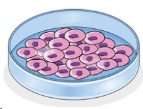Stem cell differentiation plays a pivotal role in regenerative medicine, offering a promising avenue for generating specialized cells with therapeutic potential.
In this protocol, Creative Biolabs outlines a step-by-step procedure for differentiating stem cells into thyroid progenitor cells. This protocol is designed to provide researchers with a comprehensive guide, emphasizing the materials required, detailed procedures, and important notes to ensure successful differentiation.

Thaw and culture stem cells on Matrigel-coated dishes using the pluripotent stem cell medium. Maintain cells in an undifferentiated state by changing the medium every day and splitting the cells when reaching 70-80% confluency.


Replace pluripotent medium with differentiation medium containing BMP4 and FGF. Culture cells for 4-5 days, changing the medium every day. Monitor the emergence of definitive endoderm markers, such as FOXA2 and SOX17, using immunostaining or RT-PCR.


Induce anteriorization by adding RA and Noggin to the differentiation medium. Culture cells for an additional 5-7 days, changing the medium every 2-3 days. Confirm the expression of anterior markers like NKX2.1 and PAX8 through immunostaining or RT-PCR.


Transition to a differentiation medium supplemented with TSH, insulin, transferrin, and selenium. Culture cells for an additional 10-14 days, changing the medium every 2-3 days. Confirm the maturation of thyroid progenitors by assessing the expression of thyroid-specific markers, including thyroglobulin and thyroid peroxidase.

Researchers are encouraged to adapt and optimize the protocol based on their specific cell lines and experimental conditions. The generation of thyroid progenitor cells holds great promise for advancing our understanding of thyroid development and potential applications in regenerative medicine.
By following this protocol, researchers can contribute to the growing body of knowledge in stem cell differentiation and pave the way for innovative therapeutic strategies.
Reference
For Research Use Only. Not For Clinical Use.